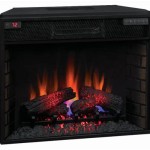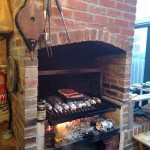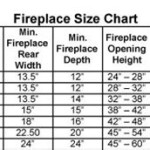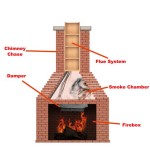Converting A Gas Fireplace To Wood Burning: A Comprehensive Guide
The allure of a wood-burning fireplace is deeply rooted in history and tradition. The crackling flames, the cozy warmth, and the distinctive aroma create an ambiance that many find irresistible. While gas fireplaces offer convenience and ease of use, some homeowners yearn for the authentic experience of burning wood. Converting a gas fireplace to a wood-burning one is a complex undertaking that requires careful consideration, thorough planning, and adherence to safety regulations. This article provides a comprehensive guide to understanding the key aspects of this conversion process.
Before embarking on this project, it is crucial to assess the existing gas fireplace and the surrounding structure. Not all gas fireplaces are suitable for conversion. The chimney, firebox, and ventilation system must meet the specific requirements for safely burning wood. Ignoring these considerations can lead to dangerous situations, including chimney fires, carbon monoxide poisoning, and structural damage.
It is strongly recommended that homeowners consult with qualified professionals, such as certified chimney sweeps, fireplace installers, and building inspectors. These experts can evaluate the existing system, identify potential problems, and provide guidance on the necessary modifications and upgrades. Obtaining the necessary permits and adhering to local building codes is paramount to ensure the safety and legality of the conversion.
Assessing the Chimney and Firebox
The chimney is arguably the most critical component of a wood-burning fireplace system. It is responsible for safely venting smoke and combustion gases out of the house. A gas fireplace chimney is often significantly different from one designed for wood burning. Gas fireplaces typically use smaller diameter vents, often made of metal, that are not designed to withstand the high temperatures and corrosive byproducts of wood combustion. Wood-burning fireplaces require a larger, masonry chimney or a specifically designed UL-listed chimney system. The chimney liner must be in good condition and capable of withstanding high temperatures. Clay tile liners are common, but stainless steel liners are often preferred for their durability and resistance to corrosion.
The firebox is the area where the wood is burned. The size and construction of the firebox must be adequate to safely contain the fire. Gas fireplaces often have smaller, shallower fireboxes than wood-burning fireplaces. Converting a gas firebox to wood-burning often involves enlarging the firebox, adding firebricks or a firebox liner, and ensuring proper clearances from combustible materials. The firebox must be constructed of non-combustible materials, such as firebrick or steel, to withstand the intense heat of a wood fire. The hearth extension must also be large enough to protect the flooring from sparks and embers.
Ventilation and Air Supply Considerations
Proper ventilation is essential for the safe and efficient operation of a wood-burning fireplace. Adequate airflow is necessary to sustain combustion and to prevent smoke from entering the house. Gas fireplaces typically rely on a sealed combustion system that draws air from outside and vents exhaust directly outside. Wood-burning fireplaces require a different approach to ventilation. They need a readily available supply of air to support combustion. This air can be drawn from inside the house, but this can create negative pressure, potentially drawing in pollutants or leading to inefficient heating. Ideally, a dedicated outside air supply should be installed to provide combustion air directly to the fireplace. This helps to maintain a balanced pressure in the house and ensures efficient combustion.
The damper is a crucial component for controlling airflow in a wood-burning fireplace. It is a metal plate that can be opened or closed to regulate the amount of air entering the chimney and to prevent drafts when the fireplace is not in use. A properly functioning damper is essential for preventing heat loss and for safely venting smoke. Inspecting and potentially replacing the damper is a critical step in the conversion process.
Necessary Modifications and Upgrades
The conversion process often involves a range of modifications and upgrades to the existing gas fireplace. These may include removing the gas line and burner assembly, installing a new chimney liner, upgrading the firebox, and adding a damper. The specific modifications required will depend on the existing conditions and the local building codes. Removing the gas line must be done by a qualified professional to ensure that the gas supply is properly capped and sealed, preventing leaks. Installing a new chimney liner is often necessary to ensure that the chimney is capable of handling the high temperatures and corrosive byproducts of wood combustion. Upgrading the firebox may involve adding firebricks or a firebox liner to protect the surrounding structure from the heat of the fire.
Installing a spark arrestor is also crucial. This device prevents sparks and embers from escaping the chimney and potentially causing a fire hazard. The spark arrestor should be regularly inspected and cleaned to ensure that it is functioning properly.
Proper installation of all components is essential for safety and performance. Using high-quality materials and following manufacturer's instructions are critical. It is strongly recommended that all work be performed by qualified professionals to ensure that the conversion is done correctly and safely.
After the conversion is complete, a thorough inspection is essential to verify that all components are functioning properly and that the system is safe to use. A certified chimney sweep can perform this inspection and provide a written report outlining any deficiencies. Regular maintenance, including annual chimney cleaning and inspection, is necessary to ensure the continued safe and efficient operation of the fireplace.
Converting a gas fireplace to a wood-burning one is a significant undertaking that requires careful planning, professional expertise, and adherence to safety regulations. By thoroughly assessing the existing system, making the necessary modifications and upgrades, and following proper safety procedures, homeowners can safely enjoy the warmth and ambiance of a wood-burning fireplace.

Want To Convert Gas Wood Fireplace Full Service Chimney
Converting A Wood Burning Fireplace Into Gas Heat Glo

Gas To Wood Fireplace Conversion Overland Park Ks Firplace Service

Wood Burner Conversion New Jersey Fireplaces Kjb

Want To Convert Gas Wood Fireplace Full Service Chimney
Can I Convert My Wood Burning Fireplace To Gas Woodlanddirect Com

Wood To Gas Fireplace Conversion In Wisconsin Free Quote Badgerland Waesha

Convert From Wood To Gas With A Insert The Kernel Burner

How To Convert A Gas Fireplace Wood

Want To Convert Gas Wood Fireplace Full Service Chimney








